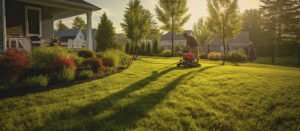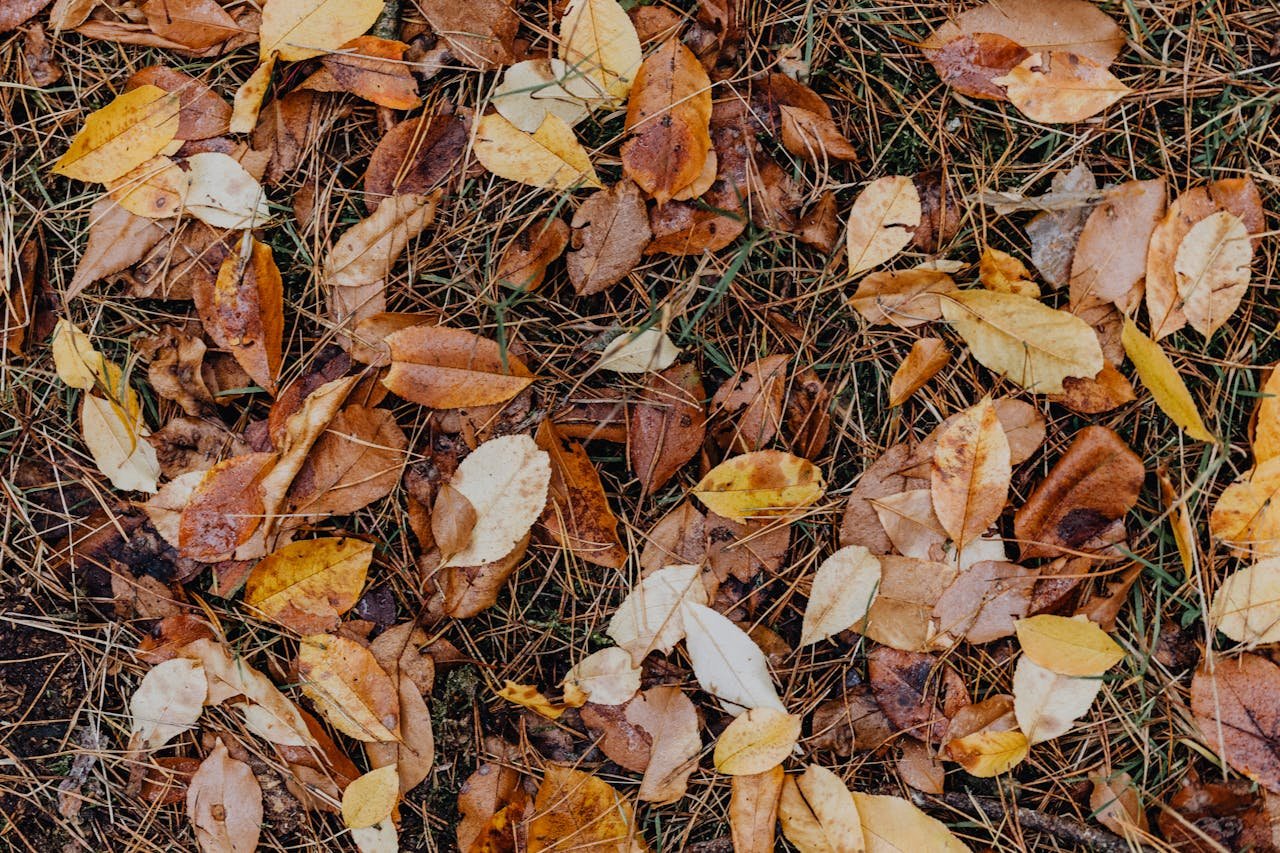Many homeowners invest time and effort in keeping their gardens in good condition. However, there are times when you should focus on getting rid of your lawn. Many homeowners spend considerable time maintaining their gardens.
What is Dead Grass?
Dead grass looks dull and lifeless and lacks the vibrant green color and upright posture of healthy grass. If your grass is dying, it might be time to start fresh with new greenery.
Dead grass resembles dormant grass but does not revive during favorable weather or with fertilizer application. If the grass is beyond saving, reseeding or replacing it can restore a lush, green lawn.
The Autumn Lawn & The Compost Pile

The best autumn lawn care isn’t just about applying a few handfuls of fine fertilizer to revive dead grass. It’s about improving the conditions for growth and ensuring that the grass is well-maintained. Think of it this way, and you’ll notice the benefits. Aerating and scarifying the dead grass can significantly improve the appearance and health of the lawn. It’s more effective than simply feeding it, particularly if followed by a thorough lawn care routine.
As the grass develops, it becomes surrounded by dead grasses, moss, and horizontal grass rhizomes that grow close to the soil beneath the layers of lush green leaves. As this layer thickens, it causes the grass stems to elongate and weakens the roots. This layer of dead grass is referred to as thatch. It can be removed through scarifying.
This can be done using a spring-tine lawn rake for a small, fine lawn. It may be worth hiring a power lawn scarifier for a larger area. Regardless of the method, scarifying during this season gives grass plants the best chance to generate side shoots, increasing the lawn’s thickness before spring.
Since grass is used for walking and playing and requires regular mowing, the ground where it grows often becomes compacted. In heavy soil, this compaction pushes air out, making it difficult for water and air to reach the grassroots.
This can also result in poor drainage, with water accumulating on the soil’s surface beneath the grass during winter. This creates conditions for liverwort and moss to thrive, competing with the grass. This is where lawn aeration becomes crucial. Spiking the lawn with a fork, walking on it with spiked shoes, or removing soil plugs with a hollow-tine lawn aerator can help resolve this issue.
What if My Grass is Yellow?
Many factors can cause a lawn to turn yellow, but the primary reason is serious soil issues.
Causes of a Yellowing Lawn
- Unhealthy soil
- Changing seasons
- Excessive pet urine
- Past stress
Insufficient nutrients in the soil can make grass vulnerable to diseases and pests, leading to yellowing. If the grass turns yellow in spring, it could indicate a nitrogen deficiency.
Planning to Remove Grass
Eliminating your lawn is a significant task. If you are considering removing grass, there are various methods to explore, each requiring time, money, and energy.
Certain methods have a more substantial environmental impact, while others may be more acceptable to your neighbors. Striking the perfect balance between these factors and understanding the advantages and disadvantages of each method will help you choose the best approach for your needs. It may also be necessary to use different methods for different lawn areas.
Additional considerations include:
- Check for homeowner association rules or local ordinances that could affect your plans.
- If you have an underground irrigation system, note the precise locations of sprinkler heads and pipes to avoid damage during work or digging.
Caution
Before excavation, contact the appropriate services to check for underground utilities.
How to Remove a Lawn With Herbicide

Applying a post-emergent, non-selective herbicide to your lawn is an effective way to kill grass. Be mindful of the types of plants the herbicide is designed to eliminate and ensure it is suitable for the job. Herbicides are available in concentrate forms that require mixing and pre-mixed, ready-to-use varieties.
While pre-mixed types are more convenient, concentrates are more cost-effective for large lawns. Follow all label directions and safety guidelines to minimize risks to yourself and the environment.
The grass should be actively growing during application. Apply the herbicide and wait 7 to 10 days for the grass to die. You may need multiple applications to kill well-established grass, which adds time and cost to the process.
Although this method is less labor-intensive than others and provides faster results, its effectiveness depends on conditions.
Rain may wash away the herbicide before it fully kills the grass, requiring additional applications. Rain can also cause chemical runoff, and wind may carry the herbicide to unintended areas, potentially affecting other plants or neighboring properties.
While herbicides can kill weeds in the grass, weed seeds in the soil may sprout later. Once the grass is dead, you will need to manage the remaining debris.
Remove a Lawn by Digging It Up
If you’re looking for a natural approach, you can remove a lawn using a tiller or a cutter. Buying a tiller will simplify the process however, you’ll need an extremely robust rear-tine model. Renting a more powerful grass-removal machine, like a sod cutter, can cut through the turf and create strips.
The strips can be rolled up for reuse or flipped over to decompose. You can also remove grass by hand using a shovel, but this procedure is extremely laborious and best for smaller grass plots.
The process of removing a lawn usually does not require herbicide. Be aware that when you remove the sod, you’re taking away organic material that you’ll need to replace.
You’ll see immediate results, as the grass will no longer be there, and you can begin preparing the soil for planting seeds and plants. If you keep the sod to compost, you’re conserving organic matter, but it also increases the time required to complete the project.
Even with a device for removing grass, the task can be challenging. There is a risk of exposing weed seeds buried deep in the soil, allowing them to sprout.
It’s also possible to remove too much topsoil. If you’re using a tiller, sod cutter, or another gas-powered device to remove sod, you’ll need to factor in fuel and possibly rental costs as part of the project’s total expenses.
The process may be more difficult if you’re dealing with a tough perennial grass like Bermuda, which has deep roots and can regenerate from root fragments. You’ll need to destroy this type of grass completely before removal, and killing it entirely may require the use of herbicide.
Remove a Lawn With Solarization
Solarization is a method that uses heat from the sun’s rays to eliminate weed seeds and pathogens in the soil. It kills the lawn by heating it until it dies.
This method requires a lot of sunshine and high temperatures to be effective, making summer the ideal time for solarization. The grass should be cut as short as possible and then watered thoroughly. Cover the grass with transparent plastic sheets and leave it in place for six to eight weeks.

Clear plastic works better than opaque types because it allows more sunlight to penetrate the grass and heat it faster. Thin plastic can work, but thicker plastic with a higher mil rating is more durable, preventing tears and cuts.
You could also use black plastic to retain heat in the soil. Black plastic blocks sunlight, preventing photosynthesis.After the grass has died and the plastic has been removed, you can remove the dead grass or let it decompose as compost.
Dead grass is easy to remove but eliminates essential organic matter. If you leave the grass, plant directly into it or till it into the soil to a depth of about one or two inches. Avoid tilling too deeply, as it could expose soil that still contains root systems, weed seeds, and pathogens.
The downside of solarization is that it may destroy beneficial and harmful organisms. A lawn covered in plastic is unattractive, and the plastic must remain in place for several weeks.
This process also depends on the weather; cold or cloudy days can slow progress. Although it’s less physically demanding than removing living turf, covering a large lawn requires effort. You’ll need to purchase a significant amount of plastic sheeting, which must be disposed of after completing the project.
Remove a Lawn by Smothering and Composting
Smothering a lawn will kill it, allowing it to compost naturally and bringing important organic material into the soil. Begin by cutting the lawn closely.
Cover the lawn with at least six layers of cardboard or newspaper. If using a newspaper, choose one with black ink, as colored inks can contain heavy metals. Ensure the layers are thick enough to block light completely.
Soak the layers thoroughly and cover them with at least four inches of grass trimmings, compost, or another organic mulch. In addition to adding organic matter, the material will help retain water and bind the layers together.
The cardboard, newspaper, and organic materials will not raise the soil temperature as plastic sheeting does. But they will block sunlight and prevent photosynthesis, destroying the grass within two months. This lawn removal technique is an alternative method that does not require herbicides.
The layers decompose, adding organic material to the soil rather than removing it. This process is not dependent on weather conditions, unlike methods that use solarization or herbicides. Once the process is complete, the soil can be used immediately. Dig it up and begin planting.
Since this method avoids digging up the lawn, it requires less manual labor and does not disturb the soil.
However, covering the lawn with layers of mulch or material requires time and effort, so be prepared for two months of a messy lawn. Large lawns will need significant mulch and cover material, which may increase costs. Additionally, this method may not be suitable for steep slopes.
Next Steps
Whatever lawn removal method you choose, there are certain steps to take after removing the grass. Even if you use a method that allows immediate planting, preparing the soil will benefit your lawn or garden. If the lawn was affected by disease or weeds, address the underlying issue to prevent recurring problems:
- Test the soil. This will provide an overview of its condition and how to improve it. Adding necessary amendments is crucial for the success of future plantings.
- Repair grading issues. This is the ideal time to elevate low spots, remove high spots, and fix any drainage problems in your yard.
- Manage pests. Removing grass can expose hidden pest problems. Inspect the soil for insect larvae and treat any issues before planting or reseeding.
- Remove new weeds. A bare bed of soil without turf can become a perfect spot for weed growth. Some weeds may sprout while waiting for the lawn-removal process to finish. Remove any that appear before proceeding.
Beginning Over When Your Lawn Is Beyond Repair
Is the grass too damaged and beyond repair? It’s time to buy premium grass seeds thoroughly. When you plant new grass, keep the top 2 inches of soil moist until the new grass grows to the height of mowing, which is about three inches.
The main concern in caring for dormant grass is restricting traffic. Hand-pulling weeds will help ensure they don’t take the nutrients or water that grass needs to grow. Also, avoid using fertilizer or applying herbicides until the lawn has healed.
Knowing the most important indicators for dead and dormant grass can help make your lawn look beautiful again. Give your yard tender care to restore it and eliminate the yellow grass.
FAQ
What’s the quickest method to repair dead grass?
How to Fix Dead Spots in Lawn
- Remove Dead Grass: The first step in repairing dead spots on your lawn is to clean off brown grass and other debris, such as sticks and rocks.
- Loosen the Soil: Prepare the area for seeding by loosening the soil.
- Scatter Grass Seed: Spread grass seed evenly over the area.
- Lightly scratch it. Gently work the seed into the soil.
- Fertilize: Apply a balanced fertilizer to encourage growth.
- Cover with Mulch: Protect the seeds with a light layer of mulch.
- Water: Keep the area consistently moist.
- Continue Proper Lawn Care: Maintain healthy practices to ensure regrowth.
Do you think dead grass should be removed?
Leaving dead grass can weaken the surrounding healthy grass and lead to further damage. Removing dead grass is essential, especially if you’re planning to plant new seeds. If there is more than a half-inch of dead grass, it should be removed before planting.
What is the quickest method to eliminate old grass?
The quickest way to remove grass is to take away the sod physically. Cut it into pieces using a lawn cutter, roll it up, and either dispose of the strips or turn them over to let them compost.

